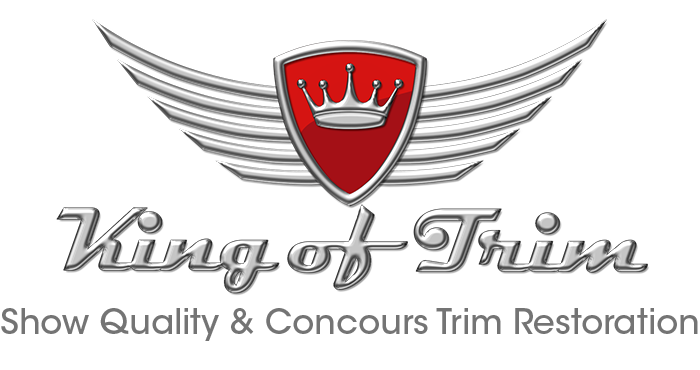FAQs
My trim parts are badly damaged, can they still be restored?
We make every effort to restore your auto trim parts to their original condition. This not always possible, however, because old trim auto parts are often corroded or damaged. Our work is performed on a “best effort” basis. Sometimes, we encounter trim which has been damaged or altered in such a way that welding is required to correct the problem. If the repair is in a visible area, the welded aluminum will show a milky appearance when anodized. The discoloration is due to the alloy used for welding and thermal changes in the aluminum. We strongly advise our customers to locate parts where welding is not required. When this is not possible welding is used as a last resort.
How do I know that I’m getting my own parts back?
When your parts arrive at our facility for restoration, we assign a work order number, then we photograph and scribe the back for identification and tracking.
How much does it cost, and how long does it take?
We evaluate the overall condition of the part, contact you with a firm and final quote and await your approval. Our turn-around time depends on the size of the order, the difficulty of the restoration, and our workload. In most cases, your order will be ready in 5 to 6 weeks. If you have a deadline, please plan ahead and give us enough time to do a good job.
How does the restoration process work?
- Stripping: Parts are stripped down to the base metal using appropriate chemicals and procedures to remove old paints and anodizing.
- Repair and straightening: Nicks, dents, bends and so on are fixed and straightened and the part is restored to its original shape. If necessary, alloy welding is used to stitch cracks and fill holes. (Note that welding in a visible area will manifest a milky discoloration on the finished restoration.)
- Polishing: Parts are ground, smoothed, and hand polished to a mirror finish, or a satin finish if required, using special materials and wheels. Polishing is a very delicate operation that requires highly skilled and qualified personnel. Our experienced polishers can remove corrosion without ruining the part, produce a high luster finish without overheating, and leave a smooth surface without undesirable marks.
- Brite Dip: First, parts are perfectly cleaned to ensure that there are no residues of polishing compound, dirt, fingerprints, oils, etc. They are then secured in a rack, which holds them in place and ensures a good contact point for electrical current. A phosphoric acid based chemical polishing (bright dip) is used to produce a highly reflective surface. Parts are then rinsed to remove chemical residues.
- Anodizing: The racks are then lowered into the anodizing baths, an electrolysis process that coats the parts with a protective anodizing film. The porous nature of the anodizing creates a surface that is excellent for painting.
- Detailing: Parts are masked depending upon the painting scheme. We have spent countless hours developing accurate painting formulations, textures and techniques to duplicate the original finishes.
How do I protect my parts for shipping and handling?
For straight pieces of trim we recommend using a PVC pipe of sufficient diameter and length to accommodate your parts. Make sure that both ends are secure to avoid losing merchandise in transit. For other pieces, use a sturdy box with plenty of padding. If possible, reinforce the corners with cardboard angle. Another alternative is to build a wooden crate. We strongly advise insuring your merchandise for full value with your carrier.
How does restored trim compare to NOS*?
Restored aluminum is superior to NOS. The attention to detail in all facets of the process cannot be duplicated in a production line. The smooth polished surface, the reflectivity of bright dipped anodized aluminum, the perfect line definition in masking and detailing, and the passion to bring an outstanding product to market makes King Of Trim restorations a better choice.
* NOS – New Old-Stock
Does aluminum need to be anodized?
Aluminum must be anodized. No car manufacturer specifies OEM trim without anodizing. The anodic layer protects metal against corrosion and will be trouble free for years. If your aluminum trim is being polished without anodizing, you risk ruining your valuable parts. They will not be properly protected, and you will also need to hand polish the parts several times a year to keep them shiny.
How do I care for anodized aluminum and stainless steel?
Exterior anodized aluminum and stainless steel automotive trim is subjected to tars, road film, mud, snow, ice and salt, which create a corrosive environment. In spite of the excellent resistance of anodized aluminum and stainless steel, prolonged, continuous exposure to these elements without cleaning can cause some local breakdown of the anodizing layer. Just as any other automotive finishes must be cleaned as soil accumulates, so must anodized aluminum and stainless steel be restored to its original appearance when soiled. Harsh chemical cleaners are not required and should not be used for maintaining aluminum anodized and stainless steel. Mild soap and water will remove most soils from anodized aluminum and stainless steel. Stubborn contaminants are readily removed with commercially available soap-impregnated steel wool cleaning pads.
Abrasive wax cleaners are also effective. Tars and other petroleum-base films can be removed with commercial solvents formulated for this purpose. Cleaners, waxes and polishes that are safe for use on automotive paint finishes are generally satisfactory for use on anodized aluminum and stainless steel trim. These should be used on the aluminum trim and stainless steel as frequently as on the rest of the automobile.
Cleaning with steam alone is not injurious to anodized aluminum or stainless steel. However, care should be taken to avoid contact of the aluminum trim with strong, uninhibited alkaline steam cleaners sometimes used to clean the lower portions of automobiles. Certain of these products can dissolve or stain anodized finishes.
